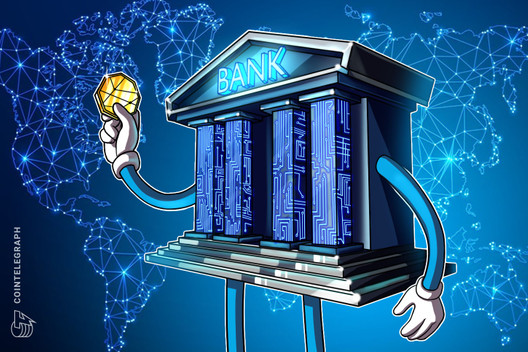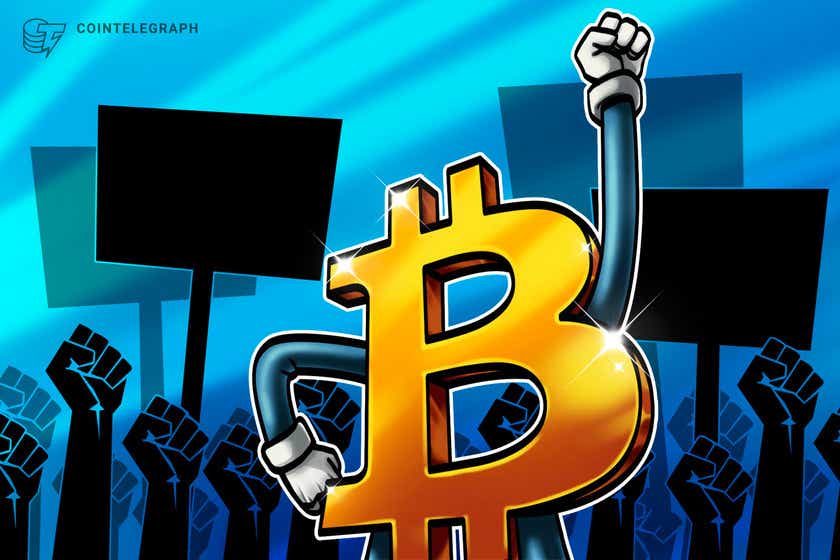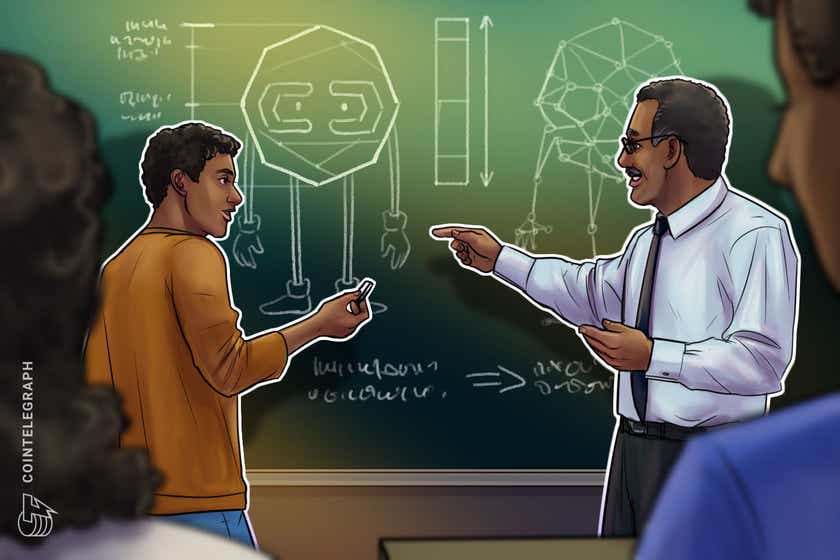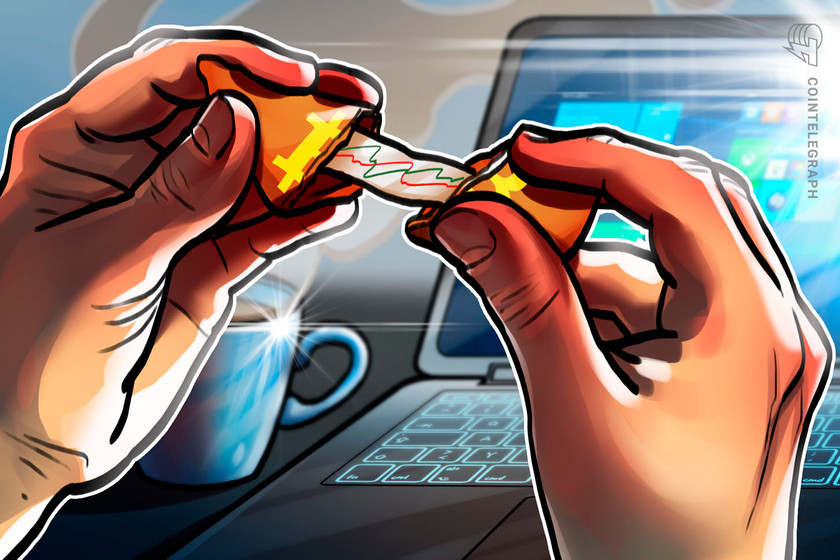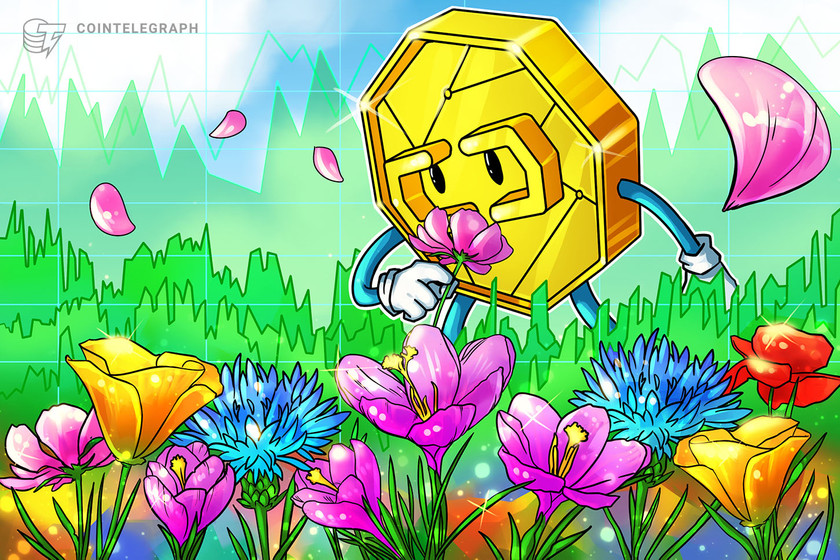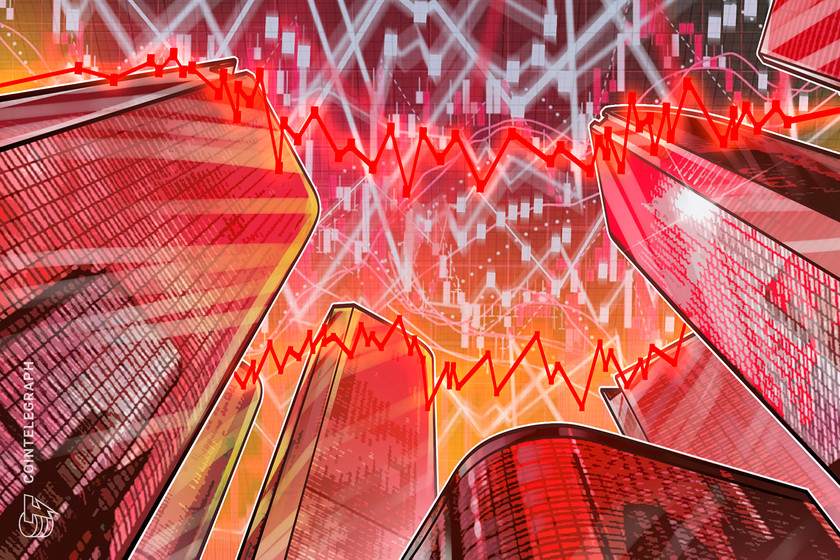What is a token maker, and how does it work?
What is Bitcoin? How does blockchain work? How to mine cryptocurrency? We are glad to help you answer these questions with our quick guides in Explained section.
rn”,”seo_description”:”What is Bitcoin? How does blockchain work? How to mine cryptocurrency? We are glad to help you answer these questions with our quick guides in Explained section.”,”enabled”:1},”words_count”:858,”description”:”A token maker provides the necessary infrastructure and functionalities for individuals or organizations to design, issue and manage their own tokens.”,”author”:{“id”:1418,”title”:”Marcel Deer”,”url”:”marcel-deer”,”twitter”:””,”google_plus”:””,”photo”:”https://s3.cointelegraph.com/storage/uploads/view/a427b150b57d0a9ad4054cf042cf01b8.jpg”,”gender”:”male”,”description”:”A qualified journalist with a background in PR and marketing, Marcel has been passionate about crypto since he first read the Cypherpunks Manifesto. As a strong believer in the power of DeFi, decentralization, and the digital economy, when he’s not writing, he’s researching the latest node projects and actively enjoying the crypto community on Twitter.”,”facebook”:””,”email”:””,”linkedin”:””,”created_at”:”2021-11-07 07:02:27″,”updated_at”:”2022-05-04 15:55:37″,”deleted_at”:null,”innovation_circle_url”:null,”avatar”:”https://images.cointelegraph.com/cdn-cgi/image/format=auto,onerror=redirect,quality=90,width=150/https://s3.cointelegraph.com/storage/uploads/view/a427b150b57d0a9ad4054cf042cf01b8.jpg”,”hash”:”aHR0cHM6Ly9jb2ludGVsZWdyYXBoLmNvbS9hdXRob3JzL21hcmNlbC1kZWVy”,”relativeUrl”:”https://cointelegraph.com/authors/marcel-deer”,”user_id”:1418,”language_id”:1,”name”:”Marcel Deer”,”desc”:”A qualified journalist with a background in PR and marketing, Marcel has been passionate about crypto since he first read the Cypherpunks Manifesto. As a strong believer in the power of DeFi, decentralization, and the digital economy, when he’s not writing, he’s researching the latest node projects and actively enjoying the crypto community on Twitter.”,”seo_title”:””,”seo_description”:””,”enabled”:1,”show_in_authors”:0,”show_in_experts”:0},”category_id”:65,”audio”:”https://s3.cointelegraph.com/audio/112757.1593f725-d042-44aa-a053-0f9d8635e76f.mp3″,”tags”:[{“name”:”Cryptocurrencies”,”uri”:”/tags/cryptocurrencies”,”super”:0,”page_title”:”Cryptocurrencies News”},{“name”:”Altcoin”,”uri”:”/tags/altcoin”,”super”:1,”page_title”:”Altcoin News”},{“name”:”Tokens”,”uri”:”/tags/tokens”,”super”:0,”page_title”:”Tokens News”}],”tag_title”:”Altcoin”,”date”:”58 MINUTES AGO”,”badge”:{“title”:”Explained”,”label”:”default”},”qty”:3,”stats_pixel”:”“,”stats_pixel_url”:”https://zoa.cointelegraph.com/pixel?postId=112757®ionId=1″,”shares”:1,”infographic”:false,”sponsored”:false,”explained”:true,”press_release”:false,”show_referral”:false,”social_description”:”Imagine creating your own cryptocurrency token in a matter of minutes — with no coding experience. The world of token makers makes this possible, let’s explore.”,”social_translators”:{“clipboard_popup_label”:”Link copied”,”socialWechatFooterError”:”WeChat error”,”socialWechatFooterText”:”WeChat share”,”socialWechatHeaderText”:”WeChat share”},”social_shares”:{“post_id”:112757,”post_url”:”https://cointelegraph.com/explained/what-is-a-token-maker-and-how-does-it-work”,”post_titles”:{“normal”:”What is a token maker, and how does it work?”,”twitter”:”What is a token maker, and how does it work?”},”post_text”:{“normal”:”What is a token maker, and how does it work?”,”twitter”:”What is a token maker, and how does it work? https://cointelegraph.com/explained/what-is-a-token-maker-and-how-does-it-work via @cointelegraph”},”accounts”:{“twitter”:”@cointelegraph”}},”socials”:{“facebook”:{“url”:”https://www.facebook.com/sharer/sharer.php?u=https%3A%2F%2Fcointelegraph.com%2Fexplained%2Fwhat-is-a-token-maker-and-how-does-it-work”,”count”:null,”short”:”fb”,”fa”:”facebook”},”twitter”:{“url”:”https://twitter.com/intent/tweet?text=What+is+a+token+maker%2C+and+how+does+it+work%3F https%3A%2F%2Fcointelegraph.com%2Fexplained%2Fwhat-is-a-token-maker-and-how-does-it-work via @cointelegraph”,”count”:null,”short”:”tw”,”fa”:”twitter”},”telegram”:{“url”:”https://telegram.me/share/url?url=https%3A%2F%2Fcointelegraph.com%2Fexplained%2Fwhat-is-a-token-maker-and-how-does-it-work &text=What+is+a+token+maker%2C+and+how+does+it+work%3F”,”count”:null,”short”:”tg”,”fa”:”paper-plane”},”whatsapp”:{“url”:”https://api.whatsapp.com/send?text=What+is+a+token+maker%2C+and+how+does+it+work%3F&href=https%3A%2F%2Fcointelegraph.com%2Fexplained%2Fwhat-is-a-token-maker-and-how-does-it-work”,”count”:null,”short”:”wu”,”fa”:”whatsapp”},”gplus”:{“url”:”https://plus.google.com/share?url=https%3A%2F%2Fcointelegraph.com%2Fexplained%2Fwhat-is-a-token-maker-and-how-does-it-work”,”count”:null,”short”:”gplus”,”fa”:”google-plus”},”reddit”:{“url”:”https://www.reddit.com/submit?url=https%3A%2F%2Fcointelegraph.com%2Fexplained%2Fwhat-is-a-token-maker-and-how-does-it-work&title=What+is+a+token+maker%2C+and+how+does+it+work%3F”,”count”:null,”short”:”reddit”,”fa”:”reddit-alien”},”linkedin”:{“url”:”https://www.linkedin.com/shareArticle?mini=true&url=https%3A%2F%2Fcointelegraph.com%2Fexplained%2Fwhat-is-a-token-maker-and-how-does-it-work&title=What+is+a+token+maker%2C+and+how+does+it+work%3F”,”count”:null,”short”:”li”,”fa”:”linkedin”}},”hide_disclaimer”:false,”elink”:”https://cointelegraph.com”,”etitle”:”Cointelegraph”,”elogo_x2″:”https://images.cointelegraph.com/cdn-cgi/image/format=auto,onerror=redirect,quality=90,width=528/https://s3.cointelegraph.com/storage/uploads/view/ab03a2a2ce9a21dc1f0961d91731c8ba.png”,”elogo_x1″:”https://images.cointelegraph.com/cdn-cgi/image/format=auto,onerror=redirect,quality=90,width=260/https://s3.cointelegraph.com/storage/uploads/view/ab03a2a2ce9a21dc1f0961d91731c8ba.png”,”elogo_svg”:false,”content”:[{“id”:4247,”post_id”:112757,”title”:”The basics of token makers”,”content”:”
A token maker or token generator tool is a type of software used to create cryptocurrency tokens.
nn
Tokens represent various assets, including digital currencies, virtual goods, loyalty points and even real-world assets, such as real estate or artwork. Tokens may also be created to grant access to a decentralized application (DApp) or deploy token smart contracts.
nn
So, what is a token maker? Technically, token makers take the tedious task of coding out of the mix — virtually allowing anyone to create their own token and launch a new cryptocurrency.
nn
Not so long ago, cryptocurrency token development was a singularly complex task, and only advanced blockchain developers with strong blockchain programming skills could mint digital coins.
nn
As the technology evolved, however, no-code tokenization platforms like TokenMint and CoinTool developed innovative platforms that equipped virtually anyone with an aptitude for cryptocurrencies to create their own tokens.
nn
Depending on the platform, token generators can create fungible or nonfungible tokens (NFTs) in accordance with specific token standards (like ERC-20 and BRC-20). Aside from using automation to create and manage tokens, token creators also allow one to control certain parameters, such as token validity. Tokens may also be revoked if necessary.
nn
To ensure that the generated tokens are secure and, therefore, truly random and unpredictable, these tools usually introduce an entropy source when generating tokens. Entropy refers to the amount of uncertainty, measured in “bits,” that a malicious actor or attacker will have to face in order to determine the value of encrypted information.
nn
An entropy source, in a nutshell, is an input device on a computer that supplies random bits, raising the difficulty level that a possible attacker has to deal with when trying to access unauthorized information.
nnn”,”created_at”:”2023-07-18 20:46:19″,”updated_at”:”2023-07-18 20:48:32″,”sort”:1,”translations”:{“id”:4240,”explained_post_id”:4247,”title_en”:”The basics of token makers”,”content_en”:”
A token maker or token generator tool is a type of software used to create cryptocurrency tokens.
nn
Tokens represent various assets, including digital currencies, virtual goods, loyalty points and even real-world assets, such as real estate or artwork. Tokens may also be created to grant access to a decentralized application (DApp) or deploy token smart contracts.
nn
So, what is a token maker? Technically, token makers take the tedious task of coding out of the mix — virtually allowing anyone to create their own token and launch a new cryptocurrency.
nn
Not so long ago, cryptocurrency token development was a singularly complex task, and only advanced blockchain developers with strong blockchain programming skills could mint digital coins.
nn
As the technology evolved, however, no-code tokenization platforms like TokenMint and CoinTool developed innovative platforms that equipped virtually anyone with an aptitude for cryptocurrencies to create their own tokens.
nn
Depending on the platform, token generators can create fungible or nonfungible tokens (NFTs) in accordance with specific token standards (like ERC-20 and BRC-20). Aside from using automation to create and manage tokens, token creators also allow one to control certain parameters, such as token validity. Tokens may also be revoked if necessary.
nn
To ensure that the generated tokens are secure and, therefore, truly random and unpredictable, these tools usually introduce an entropy source when generating tokens. Entropy refers to the amount of uncertainty, measured in “bits,” that a malicious actor or attacker will have to face in order to determine the value of encrypted information.
nn
An entropy source, in a nutshell, is an input device on a computer that supplies random bits, raising the difficulty level that a possible attacker has to deal with when trying to access unauthorized information.
nnn”,”title_es”:””,”content_es”:”n”,”title_cn”:””,”content_cn”:”n”,”title_de”:””,”content_de”:”n”,”title_fr”:””,”content_fr”:”n”,”title_it”:””,”content_it”:”n”,”title_ar”:””,”content_ar”:”n”,”title_br”:””,”content_br”:”n”,”title_jp”:””,”content_jp”:”n”,”created_at”:”2023-07-18 20:46:19″,”updated_at”:”2023-07-18 20:48:32″,”title_kr”:””,”content_kr”:”n”,”title_tr”:””,”content_tr”:”n”}},{“id”:4248,”post_id”:112757,”title”:”No-code token generation: How token generators work”,”content”:”
A token generator simplifies the tokenization process through automation while integrating custom tokenomics and ensuring privacy.
nn
Token generators streamline the process of token creation with automated drag-and-drop functions, eliminating the barriers to tokenization that cryptocurrency enthusiasts with little to no programming knowledge typically face.
nn
Tokens represent particular utilities or assets. Tokenization effectively converts something valuable into a digital token that blockchain-based applications can then effectively use. Depending on one’s desired utility, tokens can represent either tangible or intangible assets.
nn
Tangible assets are those with physical forms, such as real estate, physical artworks or gold. Intangible assets, on the other hand, may refer to things like licensing, ownership rights, loyalty points or voting rights.
nn
Developers traditionally create tokens by writing code in a programming language that the particular protocol can understand. Creating an ERC-20 token on the Ethereum blockchain, for example, will require one to determine the token’s unique specifications, codify the smart contract, test the token, and verify its source code.
nn

nn
Needless to say, one would need a lot of technical knowledge to successfully understand (and implement) how digital tokens are created. With a token generator tool, however, one can create the same ERC-20 token in as little as 10 minutes — and with zero coding.
nn
On CoinTool, for example, one will need to connect their cryptocurrency wallet to the app and start creating a token on their desired blockchain. Features can be added through a series of simple steps, such as defining the token’s name and token supply, as well as adding features and mechanisms for minting and burning.
nnn”,”created_at”:”2023-07-18 20:46:57″,”updated_at”:”2023-07-18 20:48:31″,”sort”:2,”translations”:{“id”:4241,”explained_post_id”:4248,”title_en”:”No-code token generation: How token generators work”,”content_en”:”
A token generator simplifies the tokenization process through automation while integrating custom tokenomics and ensuring privacy.
nn
Token generators streamline the process of token creation with automated drag-and-drop functions, eliminating the barriers to tokenization that cryptocurrency enthusiasts with little to no programming knowledge typically face.
nn
Tokens represent particular utilities or assets. Tokenization effectively converts something valuable into a digital token that blockchain-based applications can then effectively use. Depending on one’s desired utility, tokens can represent either tangible or intangible assets.
nn
Tangible assets are those with physical forms, such as real estate, physical artworks or gold. Intangible assets, on the other hand, may refer to things like licensing, ownership rights, loyalty points or voting rights.
nn
Developers traditionally create tokens by writing code in a programming language that the particular protocol can understand. Creating an ERC-20 token on the Ethereum blockchain, for example, will require one to determine the token’s unique specifications, codify the smart contract, test the token, and verify its source code.
nn

nn
Needless to say, one would need a lot of technical knowledge to successfully understand (and implement) how digital tokens are created. With a token generator tool, however, one can create the same ERC-20 token in as little as 10 minutes — and with zero coding.
nn
On CoinTool, for example, one will need to connect their cryptocurrency wallet to the app and start creating a token on their desired blockchain. Features can be added through a series of simple steps, such as defining the token’s name and token supply, as well as adding features and mechanisms for minting and burning.
nnn”,”title_es”:””,”content_es”:”n”,”title_cn”:””,”content_cn”:”n”,”title_de”:””,”content_de”:”n”,”title_fr”:””,”content_fr”:”n”,”title_it”:””,”content_it”:”n”,”title_ar”:””,”content_ar”:”n”,”title_br”:””,”content_br”:”n”,”title_jp”:””,”content_jp”:”n”,”created_at”:”2023-07-18 20:46:57″,”updated_at”:”2023-07-18 20:48:31″,”title_kr”:””,”content_kr”:”n”,”title_tr”:””,”content_tr”:”n”}},{“id”:4249,”post_id”:112757,”title”:”Types of cryptocurrency tokens”,”content”:”
Cryptocurrency tokens generally fall into four main categories: security tokens, utility tokens, tokenized securities and currency tokens.
nn
Security tokens represent a particular investment — like voting rights or shares in a company or centralized organization. They could also represent other valuable underlying assets or utilities, whether tangible or digital. These tokens can be programmed with a variety of ownership rights and unique characteristics.
nn
Utility tokens represent access to a blockchain-based product or service. These types of tokens may also be used to power a network’s consensus mechanism (such as proof-of-work and proof-of-stake). There are other applications as well, such as paying for transaction fees or granting voting rights within a decentralized autonomous organization.
nn
Tokenized securities, not to be confused with security tokens, refer to digital representatives of their underlying securities, such as bonds, investment funds or equity. The main goal, then, is to broaden a security’s liquidity or market accessibility. As such, there are typically no unique features or cryptographic characteristics embedded in these tokens.
nn
Lastly, currency tokens are tokens designed to function as digital currencies that can be traded and spent. Some currency tokens are also asset-backed, but many are not tied to underlying assets. The value of these tokens lies in their underlying blockchain network and distribution mechanism.
nnn”,”created_at”:”2023-07-18 20:47:16″,”updated_at”:”2023-07-18 20:48:30″,”sort”:3,”translations”:{“id”:4242,”explained_post_id”:4249,”title_en”:”Types of cryptocurrency tokens”,”content_en”:”
Cryptocurrency tokens generally fall into four main categories: security tokens, utility tokens, tokenized securities and currency tokens.
nn
Security tokens represent a particular investment — like voting rights or shares in a company or centralized organization. They could also represent other valuable underlying assets or utilities, whether tangible or digital. These tokens can be programmed with a variety of ownership rights and unique characteristics.
nn
Utility tokens represent access to a blockchain-based product or service. These types of tokens may also be used to power a network’s consensus mechanism (such as proof-of-work and proof-of-stake). There are other applications as well, such as paying for transaction fees or granting voting rights within a decentralized autonomous organization.
nn
Tokenized securities, not to be confused with security tokens, refer to digital representatives of their underlying securities, such as bonds, investment funds or equity. The main goal, then, is to broaden a security’s liquidity or market accessibility. As such, there are typically no unique features or cryptographic characteristics embedded in these tokens.
nn
Lastly, currency tokens are tokens designed to function as digital currencies that can be traded and spent. Some currency tokens are also asset-backed, but many are not tied to underlying assets. The value of these tokens lies in their underlying blockchain network and distribution mechanism.
nnn”,”title_es”:””,”content_es”:”n”,”title_cn”:””,”content_cn”:”n”,”title_de”:””,”content_de”:”n”,”title_fr”:””,”content_fr”:”n”,”title_it”:””,”content_it”:”n”,”title_ar”:””,”content_ar”:”n”,”title_br”:””,”content_br”:”n”,”title_jp”:””,”content_jp”:”n”,”created_at”:”2023-07-18 20:47:16″,”updated_at”:”2023-07-18 20:48:30″,”title_kr”:””,”content_kr”:”n”,”title_tr”:””,”content_tr”:”n”}},{“id”:4250,”post_id”:112757,”title”:”Benefits and drawbacks of token generators”,”content”:”
Token generators are lauded for their convenience, security and affordability. However, they might sometimes be too simplistic for those looking for more complex smart contract applications.
nn
Among the foremost benefits of token generators are convenience and affordability, as there would be no need to enlist the help of a blockchain programmer to code a smart contract. And, if one uses a reputable token maker platform, the process can also be highly secure and efficient.
nn
On the other hand, token generators do have several drawbacks. For one, their “plug-and-play” nature can also make them less customizable and might lack features found in more complex smart contracts. Furthermore, some platforms may charge hefty fees for using their service or might require users to pay for certain assets.
nn
Overall, though, token generators are an incredibly useful tool for entrepreneurs and developers looking to create digital tokens quickly and securely. As the cryptocurrency space continues to evolve, these types of tools are also primed to become more intuitive and secure in the coming years.
nnn”,”created_at”:”2023-07-18 20:47:33″,”updated_at”:”2023-07-18 20:48:30″,”sort”:4,”translations”:{“id”:4243,”explained_post_id”:4250,”title_en”:”Benefits and drawbacks of token generators”,”content_en”:”
Token generators are lauded for their convenience, security and affordability. However, they might sometimes be too simplistic for those looking for more complex smart contract applications.
nn
Among the foremost benefits of token generators are convenience and affordability, as there would be no need to enlist the help of a blockchain programmer to code a smart contract. And, if one uses a reputable token maker platform, the process can also be highly secure and efficient.
nn
On the other hand, token generators do have several drawbacks. For one, their “plug-and-play” nature can also make them less customizable and might lack features found in more complex smart contracts. Furthermore, some platforms may charge hefty fees for using their service or might require users to pay for certain assets.
nn
Overall, though, token generators are an incredibly useful tool for entrepreneurs and developers looking to create digital tokens quickly and securely. As the cryptocurrency space continues to evolve, these types of tools are also primed to become more intuitive and secure in the coming years.
nnn”,”title_es”:””,”content_es”:”n”,”title_cn”:””,”content_cn”:”n”,”title_de”:””,”content_de”:”n”,”title_fr”:””,”content_fr”:”n”,”title_it”:””,”content_it”:”n”,”title_ar”:””,”content_ar”:”n”,”title_br”:””,”content_br”:”n”,”title_jp”:””,”content_jp”:”n”,”created_at”:”2023-07-18 20:47:33″,”updated_at”:”2023-07-18 20:48:30″,”title_kr”:””,”content_kr”:”n”,”title_tr”:””,”content_tr”:”n”}},{“id”:4251,”post_id”:112757,”title”:”Key considerations while selecting a good token maker”,”content”:”
A good token maker should be secure, rich in features and reputable.
nn
Picking the right token maker is paramount in ensuring that token creation is successful. First, a token generator platform should ideally be from a reputable name and not a fly-by-night platform on the internet with flimsy technicals. It’s always a good idea to research the platform before deciding to use it for token creation, as well as read other users’ reviews about it.
nn
A good token generator will also offer a wide range of features, such as the ability to expire, burn, mint or blacklist tokens. The price and user experience of the tool are also important considerations. Look into the fees and level of customization allowed (if any), and if these match your budget and needs.
nn
Lastly, a good token generator is one that is secure and regularly updated by its developers. Look for bug reporting facilities and update schedules to ensure the DApp is kept updated and maintained.
nn
Here are some examples of token maker platforms that help create tokens:
nn
CoinTool
nn
CoinTool allows for the creation of a wide range of tokens, including ERC-20 and BEP-20 tokens. Users can also create tokens for Solana, Polygon, Avalanche and more. The tool offers a drag-and-drop token creation interface and other helpful features, such as NFT creator, contract auditor and gas price index.
nn
TokenMint
nn
TokenMint by Horizen facilitates the creation of fungible tokens with custom tokenomics in a fully transparent environment. The platform also offers enhanced privacy and security. To use the generator, however, one must first download the Cobalt wallet and fund it with Horizen (ZEN) cryptocurrency to pay for token generation fees.
nn
Create My Token
nn
This platform allows users to create BEP-20 and ERC-20 tokens without coding. One simply has to connect their MetaMask wallet, customize the details and features of their token, and deploy the same. Gas fees apply.
nnn”,”created_at”:”2023-07-18 20:47:55″,”updated_at”:”2023-07-18 20:48:30″,”sort”:5,”translations”:{“id”:4244,”explained_post_id”:4251,”title_en”:”Key considerations while selecting a good token maker”,”content_en”:”
A good token maker should be secure, rich in features and reputable.
nn
Picking the right token maker is paramount in ensuring that token creation is successful. First, a token generator platform should ideally be from a reputable name and not a fly-by-night platform on the internet with flimsy technicals. It’s always a good idea to research the platform before deciding to use it for token creation, as well as read other users’ reviews about it.
nn
A good token generator will also offer a wide range of features, such as the ability to expire, burn, mint or blacklist tokens. The price and user experience of the tool are also important considerations. Look into the fees and level of customization allowed (if any), and if these match your budget and needs.
nn
Lastly, a good token generator is one that is secure and regularly updated by its developers. Look for bug reporting facilities and update schedules to ensure the DApp is kept updated and maintained.
nn
Here are some examples of token maker platforms that help create tokens:
nn
CoinTool
nn
CoinTool allows for the creation of a wide range of tokens, including ERC-20 and BEP-20 tokens. Users can also create tokens for Solana, Polygon, Avalanche and more. The tool offers a drag-and-drop token creation interface and other helpful features, such as NFT creator, contract auditor and gas price index.
nn
TokenMint
nn
TokenMint by Horizen facilitates the creation of fungible tokens with custom tokenomics in a fully transparent environment. The platform also offers enhanced privacy and security. To use the generator, however, one must first download the Cobalt wallet and fund it with Horizen (ZEN) cryptocurrency to pay for token generation fees.
nn
Create My Token
nn
This platform allows users to create BEP-20 and ERC-20 tokens without coding. One simply has to connect their MetaMask wallet, customize the details and features of their token, and deploy the same. Gas fees apply.
nnn”,”title_es”:””,”content_es”:”n”,”title_cn”:””,”content_cn”:”n”,”title_de”:””,”content_de”:”n”,”title_fr”:””,”content_fr”:”n”,”title_it”:””,”content_it”:”n”,”title_ar”:””,”content_ar”:”n”,”title_br”:””,”content_br”:”n”,”title_jp”:””,”content_jp”:”n”,”created_at”:”2023-07-18 20:47:55″,”updated_at”:”2023-07-18 20:48:30″,”title_kr”:””,”content_kr”:”n”,”title_tr”:””,”content_tr”:”n”}}],”is_partner_material”:false,”commentsSection”:{“schemaEntityUrl”:”//cointelegraph.com/explained/what-is-a-token-maker-and-how-does-it-work”,”list”:[],”amount”:0,”i18n”:{“addComment”:”Add a comment…”,”amountOnePostfix”:”Comment”,”amountPostfix”:”Comments”,”cancel”:”Cancel”,”delete”:”Delete”,”edit”:”Edit”,”errorBig”:”Comment text cannot be longer than 2000 characters”,”errorDuplicate”:”Duplicate comment”,”errorSmall”:”Comment text must be at least 2 characters long”,”hideButton”:”Hide comments”,”noComments”:” “,”commentOnModeration”:”Comment on moderation”,”postComment”:”Post”,”reply”:”Reply”,”showAllComments”:”Show All Comments”,”showButtonPostfix”:”comments”,”showButtonPrefix”:”Show”,”signIn”:”Sign in”,”update”:”Update comment”,”commentWasDeleted”:”This comment has been deleted”}},”related”:[{“id”:107902,”retina”:”https://images.cointelegraph.com/cdn-cgi/image/format=auto,onerror=redirect,quality=90,width=1480/https://s3.cointelegraph.com/uploads/2023-05/8e03be25-40e5-4697-9994-490a45e73e72.jpg”,”img”:”https://images.cointelegraph.com/cdn-cgi/image/format=auto,onerror=redirect,quality=90,width=740/https://s3.cointelegraph.com/uploads/2023-05/8e03be25-40e5-4697-9994-490a45e73e72.jpg”,”thumb”:”https://images.cointelegraph.com/cdn-cgi/image/format=auto,onerror=redirect,quality=90,width=370/https://s3.cointelegraph.com/uploads/2023-05/8e03be25-40e5-4697-9994-490a45e73e72.jpg”,”thumb370″:”https://images.cointelegraph.com/cdn-cgi/image/format=auto,onerror=redirect,quality=90,width=370/https://s3.cointelegraph.com/uploads/2023-05/8e03be25-40e5-4697-9994-490a45e73e72.jpg”,”amp_thumb”:”https://images.cointelegraph.com/cdn-cgi/image/format=auto,onerror=redirect,quality=90,width=150/https://s3.cointelegraph.com/uploads/2023-05/8e03be25-40e5-4697-9994-490a45e73e72.jpg”,”thumb150″:”https://images.cointelegraph.com/cdn-cgi/image/format=auto,onerror=redirect,quality=90,width=150/https://s3.cointelegraph.com/uploads/2023-05/8e03be25-40e5-4697-9994-490a45e73e72.jpg”,”url”:”https://cointelegraph.com/news/how-to-check-an-ethereum-transaction”,”title”:”How to check an Ethereum transaction “,”lead”:”To check an Ethereum transaction, use a blockchain explorer and enter the transaction hash to view details such as sender/receiver addresses and gas fees.”,”leadfull”:””,”category_id”:19,”category_url”:”https://cointelegraph.com/category/analysis”,”category_title”:”Analysis”,”author_url”:”https://cointelegraph.com/authors/marcel-deer”,”author_hash”:”aHR0cHM6Ly9jb2ludGVsZWdyYXBoLmNvbS9hdXRob3JzL21hcmNlbC1kZWVy”,”author_title”:”Marcel Deer”,”author_img”:”https://images.cointelegraph.com/cdn-cgi/image/format=auto,onerror=redirect,quality=90,width=32/https://s3.cointelegraph.com/storage/uploads/view/a427b150b57d0a9ad4054cf042cf01b8.jpg”,”date”:”MAY 06, 2023″,”flash_date”:”MAY 06, 2023″,”sponsored”:false,”press_release”:false,”sponsored_label”:”Sponsored”,”explained”:false,”badge”:{“title”:”How to”,”label”:”default”},”published”:{“date”:”2023-05-06 09:07:00.000000″,”timezone_type”:3,”timezone”:”Europe/London”},”stat_uniqs”:7482,”rss_date”:”Sat, 06 May 2023 09:07:00 +0100″,”publishedW3″:”2023-05-06T09:07:00+01:00″,”show_referral”:true,”isMagazine”:false},{“id”:112014,”retina”:”https://images.cointelegraph.com/cdn-cgi/image/format=auto,onerror=redirect,quality=90,width=1480/https://s3.cointelegraph.com/uploads/2023-07/b5e4173d-9ed5-4415-a078-48e6d3171992.jpg”,”img”:”https://images.cointelegraph.com/cdn-cgi/image/format=auto,onerror=redirect,quality=90,width=740/https://s3.cointelegraph.com/uploads/2023-07/b5e4173d-9ed5-4415-a078-48e6d3171992.jpg”,”thumb”:”https://images.cointelegraph.com/cdn-cgi/image/format=auto,onerror=redirect,quality=90,width=370/https://s3.cointelegraph.com/uploads/2023-07/b5e4173d-9ed5-4415-a078-48e6d3171992.jpg”,”thumb370″:”https://images.cointelegraph.com/cdn-cgi/image/format=auto,onerror=redirect,quality=90,width=370/https://s3.cointelegraph.com/uploads/2023-07/b5e4173d-9ed5-4415-a078-48e6d3171992.jpg”,”amp_thumb”:”https://images.cointelegraph.com/cdn-cgi/image/format=auto,onerror=redirect,quality=90,width=150/https://s3.cointelegraph.com/uploads/2023-07/b5e4173d-9ed5-4415-a078-48e6d3171992.jpg”,”thumb150″:”https://images.cointelegraph.com/cdn-cgi/image/format=auto,onerror=redirect,quality=90,width=150/https://s3.cointelegraph.com/uploads/2023-07/b5e4173d-9ed5-4415-a078-48e6d3171992.jpg”,”url”:”https://cointelegraph.com/news/barnbridge-dao-calls-halt-on-work-amid-sec-investigation”,”title”:”BarnBridge DAO calls halt to ‘all work’ on DeFi protocol amid SEC probe”,”lead”:”Some DAO members joked about the situation, while others believed an ulterior motive might be at play.”,”leadfull”:””,”category_id”:2,”category_url”:”https://cointelegraph.com/category/latest-news”,”category_title”:”Latest News”,”author_url”:”https://cointelegraph.com/authors/brayden-lindrea”,”author_hash”:”aHR0cHM6Ly9jb2ludGVsZWdyYXBoLmNvbS9hdXRob3JzL2JyYXlkZW4tbGluZHJlYQ==”,”author_title”:” Brayden Lindrea “,”author_img”:”https://images.cointelegraph.com/cdn-cgi/image/format=auto,onerror=redirect,quality=90,width=32/https://s3.cointelegraph.com/storage/uploads/view/833595a19b7b66483f6e9fd16e2aaafa.jpg”,”date”:”JUL 07, 2023″,”flash_date”:”JUL 07, 2023″,”sponsored”:false,”press_release”:false,”sponsored_label”:”Sponsored”,”explained”:false,”badge”:{“title”:”News”,”label”:”default”},”published”:{“date”:”2023-07-07 06:41:00.000000″,”timezone_type”:3,”timezone”:”Europe/London”},”stat_uniqs”:3165,”rss_date”:”Fri, 07 Jul 2023 06:41:00 +0100″,”publishedW3″:”2023-07-07T06:41:00+01:00″,”show_referral”:true,”isMagazine”:false},{“id”:112602,”retina”:”https://images.cointelegraph.com/cdn-cgi/image/format=auto,onerror=redirect,quality=90,width=1480/https://s3.cointelegraph.com/uploads/2023-07/589fe004-7289-43e5-ae76-e17d89b2888a.jpg”,”img”:”https://images.cointelegraph.com/cdn-cgi/image/format=auto,onerror=redirect,quality=90,width=740/https://s3.cointelegraph.com/uploads/2023-07/589fe004-7289-43e5-ae76-e17d89b2888a.jpg”,”thumb”:”https://images.cointelegraph.com/cdn-cgi/image/format=auto,onerror=redirect,quality=90,width=370/https://s3.cointelegraph.com/uploads/2023-07/589fe004-7289-43e5-ae76-e17d89b2888a.jpg”,”thumb370″:”https://images.cointelegraph.com/cdn-cgi/image/format=auto,onerror=redirect,quality=90,width=370/https://s3.cointelegraph.com/uploads/2023-07/589fe004-7289-43e5-ae76-e17d89b2888a.jpg”,”amp_thumb”:”https://images.cointelegraph.com/cdn-cgi/image/format=auto,onerror=redirect,quality=90,width=150/https://s3.cointelegraph.com/uploads/2023-07/589fe004-7289-43e5-ae76-e17d89b2888a.jpg”,”thumb150″:”https://images.cointelegraph.com/cdn-cgi/image/format=auto,onerror=redirect,quality=90,width=150/https://s3.cointelegraph.com/uploads/2023-07/589fe004-7289-43e5-ae76-e17d89b2888a.jpg”,”url”:”https://cointelegraph.com/news/bitcoin-price-support-at-30k-opens-the-door-for-gains-from-uni-arb-aave-and-mkr”,”title”:”Bitcoin price support at $30K opens the door for gains from UNI, ARB, AAVE and MKR”,”lead”:”BTC price is back in its range, potentially given opportunities for UNI, ARB, AAVE and MKR to move higher.”,”leadfull”:””,”category_id”:89,”category_url”:”https://cointelegraph.com/category/market-analysis”,”category_title”:”Market Analysis”,”author_url”:”https://cointelegraph.com/authors/rakesh-upadhyay”,”author_hash”:”aHR0cHM6Ly9jb2ludGVsZWdyYXBoLmNvbS9hdXRob3JzL3Jha2VzaC11cGFkaHlheQ==”,”author_title”:” Rakesh Upadhyay “,”author_img”:”https://images.cointelegraph.com/cdn-cgi/image/format=auto,onerror=redirect,quality=90,width=32/https://s3.cointelegraph.com/storage/uploads/view/f10b99b4bae7c37e4f1752f3b6b7228a.jpg”,”date”:”JUL 16, 2023″,”flash_date”:”JUL 16, 2023″,”sponsored”:false,”press_release”:false,”sponsored_label”:”Sponsored”,”explained”:false,”badge”:{“title”:”Price Analysis”,”label”:”default”},”published”:{“date”:”2023-07-16 20:15:23.000000″,”timezone_type”:3,”timezone”:”Europe/London”},”stat_uniqs”:3709,”rss_date”:”Sun, 16 Jul 2023 20:15:23 +0100″,”publishedW3″:”2023-07-16T20:15:23+01:00″,”show_referral”:true,”isMagazine”:false},{“id”:112624,”retina”:”https://images.cointelegraph.com/cdn-cgi/image/format=auto,onerror=redirect,quality=90,width=1480/https://s3.cointelegraph.com/uploads/2023-07/1605a5d7-2fc4-4ef3-8940-4eb5559c9ef5.jpg”,”img”:”https://images.cointelegraph.com/cdn-cgi/image/format=auto,onerror=redirect,quality=90,width=740/https://s3.cointelegraph.com/uploads/2023-07/1605a5d7-2fc4-4ef3-8940-4eb5559c9ef5.jpg”,”thumb”:”https://images.cointelegraph.com/cdn-cgi/image/format=auto,onerror=redirect,quality=90,width=370/https://s3.cointelegraph.com/uploads/2023-07/1605a5d7-2fc4-4ef3-8940-4eb5559c9ef5.jpg”,”thumb370″:”https://images.cointelegraph.com/cdn-cgi/image/format=auto,onerror=redirect,quality=90,width=370/https://s3.cointelegraph.com/uploads/2023-07/1605a5d7-2fc4-4ef3-8940-4eb5559c9ef5.jpg”,”amp_thumb”:”https://images.cointelegraph.com/cdn-cgi/image/format=auto,onerror=redirect,quality=90,width=150/https://s3.cointelegraph.com/uploads/2023-07/1605a5d7-2fc4-4ef3-8940-4eb5559c9ef5.jpg”,”thumb150″:”https://images.cointelegraph.com/cdn-cgi/image/format=auto,onerror=redirect,quality=90,width=150/https://s3.cointelegraph.com/uploads/2023-07/1605a5d7-2fc4-4ef3-8940-4eb5559c9ef5.jpg”,”url”:”https://cointelegraph.com/news/7-payment-gateways”,”title”:”7 payment gateways for fast online transactions”,”lead”:”Explore seven payment gateways prioritizing speed and efficiency, ensuring fast, seamless online transactions.”,”leadfull”:””,”category_id”:19,”category_url”:”https://cointelegraph.com/category/analysis”,”category_title”:”Analysis”,”author_url”:”https://cointelegraph.com/authors/alice-ivey”,”author_hash”:”aHR0cHM6Ly9jb2ludGVsZWdyYXBoLmNvbS9hdXRob3JzL2FsaWNlLWl2ZXk=”,”author_title”:” Alice Ivey “,”author_img”:”https://cointelegraph.com/assets/img/icons/author_female.png”,”date”:”JUL 17, 2023″,”flash_date”:”JUL 17, 2023″,”sponsored”:false,”press_release”:false,”sponsored_label”:”Sponsored”,”explained”:false,”badge”:{“title”:”Overview”,”label”:”success”},”published”:{“date”:”2023-07-17 15:07:00.000000″,”timezone_type”:3,”timezone”:”Europe/London”},”stat_uniqs”:1761,”rss_date”:”Mon, 17 Jul 2023 15:07:00 +0100″,”publishedW3″:”2023-07-17T15:07:00+01:00″,”show_referral”:true,”isMagazine”:false},{“id”:112663,”retina”:”https://images.cointelegraph.com/cdn-cgi/image/format=auto,onerror=redirect,quality=90,width=1480/https://s3.cointelegraph.com/uploads/2023-07/fd8e40d1-0a0f-4e0d-afbc-bd2ffdbd39eb.jpg”,”img”:”https://images.cointelegraph.com/cdn-cgi/image/format=auto,onerror=redirect,quality=90,width=740/https://s3.cointelegraph.com/uploads/2023-07/fd8e40d1-0a0f-4e0d-afbc-bd2ffdbd39eb.jpg”,”thumb”:”https://images.cointelegraph.com/cdn-cgi/image/format=auto,onerror=redirect,quality=90,width=370/https://s3.cointelegraph.com/uploads/2023-07/fd8e40d1-0a0f-4e0d-afbc-bd2ffdbd39eb.jpg”,”thumb370″:”https://images.cointelegraph.com/cdn-cgi/image/format=auto,onerror=redirect,quality=90,width=370/https://s3.cointelegraph.com/uploads/2023-07/fd8e40d1-0a0f-4e0d-afbc-bd2ffdbd39eb.jpg”,”amp_thumb”:”https://images.cointelegraph.com/cdn-cgi/image/format=auto,onerror=redirect,quality=90,width=150/https://s3.cointelegraph.com/uploads/2023-07/fd8e40d1-0a0f-4e0d-afbc-bd2ffdbd39eb.jpg”,”thumb150″:”https://images.cointelegraph.com/cdn-cgi/image/format=auto,onerror=redirect,quality=90,width=150/https://s3.cointelegraph.com/uploads/2023-07/fd8e40d1-0a0f-4e0d-afbc-bd2ffdbd39eb.jpg”,”url”:”https://cointelegraph.com/news/price-analysis-7-17-spx-dxy-btc-eth-xrp-bnb-sol-ada-doge-matic”,”title”:”Price analysis 7/17: SPX, DXY, BTC, ETH, XRP, BNB, SOL, ADA, DOGE, MATIC”,”lead”:”Bitcoin bulls have failed to step in, increasing the chance for a retest of the $29,500 support.”,”leadfull”:””,”category_id”:87,”category_url”:”https://cointelegraph.com/category/top-10-cryptocurrencies”,”category_title”:”Top 10 Cryptocurrencies”,”author_url”:”https://cointelegraph.com/authors/rakesh-upadhyay”,”author_hash”:”aHR0cHM6Ly9jb2ludGVsZWdyYXBoLmNvbS9hdXRob3JzL3Jha2VzaC11cGFkaHlheQ==”,”author_title”:” Rakesh Upadhyay “,”author_img”:”https://images.cointelegraph.com/cdn-cgi/image/format=auto,onerror=redirect,quality=90,width=32/https://s3.cointelegraph.com/storage/uploads/view/f10b99b4bae7c37e4f1752f3b6b7228a.jpg”,”date”:”JUL 17, 2023″,”flash_date”:”JUL 17, 2023″,”sponsored”:false,”press_release”:false,”sponsored_label”:”Sponsored”,”explained”:false,”badge”:{“title”:”Price Analysis”,”label”:”default”},”published”:{“date”:”2023-07-17 19:30:00.000000″,”timezone_type”:3,”timezone”:”Europe/London”},”stat_uniqs”:5231,”rss_date”:”Mon, 17 Jul 2023 19:30:00 +0100″,”publishedW3″:”2023-07-17T19:30:00+01:00″,”show_referral”:true,”isMagazine”:false},{“id”:112664,”retina”:”https://images.cointelegraph.com/cdn-cgi/image/format=auto,onerror=redirect,quality=90,width=1480/https://s3.cointelegraph.com/uploads/2023-07/3d4e1f44-71c9-43dd-9a8f-714af088acdb.jpg”,”img”:”https://images.cointelegraph.com/cdn-cgi/image/format=auto,onerror=redirect,quality=90,width=740/https://s3.cointelegraph.com/uploads/2023-07/3d4e1f44-71c9-43dd-9a8f-714af088acdb.jpg”,”thumb”:”https://images.cointelegraph.com/cdn-cgi/image/format=auto,onerror=redirect,quality=90,width=370/https://s3.cointelegraph.com/uploads/2023-07/3d4e1f44-71c9-43dd-9a8f-714af088acdb.jpg”,”thumb370″:”https://images.cointelegraph.com/cdn-cgi/image/format=auto,onerror=redirect,quality=90,width=370/https://s3.cointelegraph.com/uploads/2023-07/3d4e1f44-71c9-43dd-9a8f-714af088acdb.jpg”,”amp_thumb”:”https://images.cointelegraph.com/cdn-cgi/image/format=auto,onerror=redirect,quality=90,width=150/https://s3.cointelegraph.com/uploads/2023-07/3d4e1f44-71c9-43dd-9a8f-714af088acdb.jpg”,”thumb150″:”https://images.cointelegraph.com/cdn-cgi/image/format=auto,onerror=redirect,quality=90,width=150/https://s3.cointelegraph.com/uploads/2023-07/3d4e1f44-71c9-43dd-9a8f-714af088acdb.jpg”,”url”:”https://cointelegraph.com/news/bitcoin-crypto-investment-funds-fourth-straight-week-inflows-coinshares”,”title”:”Inflows into crypto investment funds rise as Bitcoin carries 99% of the load”,”lead”:”However, Ethereum saw outflows in the amount of $2 million and remains the asset with the most outflows year-to-date.”,”leadfull”:””,”category_id”:2,”category_url”:”https://cointelegraph.com/category/latest-news”,”category_title”:”Latest News”,”author_url”:”https://cointelegraph.com/authors/tristan-greene”,”author_hash”:”aHR0cHM6Ly9jb2ludGVsZWdyYXBoLmNvbS9hdXRob3JzL3RyaXN0YW4tZ3JlZW5l”,”author_title”:” Tristan Greene “,”author_img”:”https://images.cointelegraph.com/cdn-cgi/image/format=auto,onerror=redirect,quality=90,width=32/https://s3.cointelegraph.com/storage/uploads/view/96e94298f68091cfbe0490dbd99554fa.jpg”,”date”:”JUL 17, 2023″,”flash_date”:”JUL 17, 2023″,”sponsored”:false,”press_release”:false,”sponsored_label”:”Sponsored”,”explained”:false,”badge”:{“title”:”News”,”label”:”default”},”published”:{“date”:”2023-07-17 21:00:00.000000″,”timezone_type”:3,”timezone”:”Europe/London”},”stat_uniqs”:2931,”rss_date”:”Mon, 17 Jul 2023 21:00:00 +0100″,”publishedW3″:”2023-07-17T21:00:00+01:00″,”show_referral”:true,”isMagazine”:false}]}” :shares=”{“facebook”:{“url”:”https://www.facebook.com/sharer/sharer.php?u=%URL%”,”icon”:”facebook”,”title”:”Facebook”,”sizesAllowed”:[{“size”:”lg”,”label”:”Large devices”,”breakpoint”:”> 1200px”},{“size”:”md”,”label”:”Medium devices”,”breakpoint”:”> 992px”},{“size”:”sm”,”label”:”Small tablets”,”breakpoint”:”> 768px”},{“size”:”xs”,”label”:”Smartphones”,”breakpoint”:”> 480px”},{“size”:”xxs”,”label”:”Extra small devices”,”breakpoint”:”< 480px"}],"position":1,"status":true},"twitter":{"url":"https://twitter.com/intent/tweet?text=%TEXT%","icon":"twitter","title":"Twitter","position":2,"status":true,"sizesAllowed":[{"size":"xxs","label":"Extra small devices","breakpoint":"< 480px"},{"size":"xs","label":"Smartphones","breakpoint":"> 480px”},{“size”:”sm”,”label”:”Small tablets”,”breakpoint”:”> 768px”},{“size”:”md”,”label”:”Medium devices”,”breakpoint”:”> 992px”},{“size”:”lg”,”label”:”Large devices”,”breakpoint”:”> 1200px”}]},”telegram”:{“url”:”https://t.me/share/url?url=%URL%&text=%TEXT%”,”icon”:”telegram”,”title”:”Telegram”,”position”:3,”status”:true,”sizesAllowed”:[{“size”:”xxs”,”label”:”Extra small devices”,”breakpoint”:”< 480px"},{"size":"xs","label":"Smartphones","breakpoint":"> 480px”},{“size”:”sm”,”label”:”Small tablets”,”breakpoint”:”> 768px”},{“size”:”md”,”label”:”Medium devices”,”breakpoint”:”> 992px”},{“size”:”lg”,”label”:”Large devices”,”breakpoint”:”> 1200px”}]},”linkedin”:{“url”:”https://www.linkedin.com/shareArticle?mini=true&url=%URL%&title=%TITLE%”,”icon”:”linked-in”,”title”:”LinkedIn”,”position”:5,”status”:true,”sizesAllowed”:[{“size”:”xxs”,”label”:”Extra small devices”,”breakpoint”:”< 480px"},{"size":"xs","label":"Smartphones","breakpoint":"> 480px”},{“size”:”sm”,”label”:”Small tablets”,”breakpoint”:”> 768px”},{“size”:”md”,”label”:”Medium devices”,”breakpoint”:”> 992px”},{“size”:”lg”,”label”:”Large devices”,”breakpoint”:”> 1200px”}]},”copy”:{“url”:”%URL%”,”icon”:”copy”,”position”:7,”title”:”Copy Link”,”sizesAllowed”:[{“size”:”xxs”,”label”:”Extra small devices”,”breakpoint”:”< 480px"},{"size":"xs","label":"Smartphones","breakpoint":"> 480px”},{“size”:”sm”,”label”:”Small tablets”,”breakpoint”:”> 768px”},{“size”:”md”,”label”:”Medium devices”,”breakpoint”:”> 992px”},{“size”:”lg”,”label”:”Large devices”,”breakpoint”:”> 1200px”}],”status”:true},”whatsapp”:{“url”:”https://wa.me/?text=%TITLE% %URL%”,”icon”:”whats-app”,”title”:”Whatsapp”,”sizesAllowed”:[{“size”:”xxs”,”label”:”Extra small devices”,”breakpoint”:”< 480px"},{"size":"xs","label":"Smartphones","breakpoint":"> 480px”},{“size”:”sm”,”label”:”Small tablets”,”breakpoint”:”> 768px”},{“size”:”md”,”label”:”Medium devices”,”breakpoint”:”> 992px”},{“size”:”lg”,”label”:”Large devices”,”breakpoint”:”> 1200px”}],”position”:6,”status”:true},”reddit”:{“url”:”https://www.reddit.com/submit?url=%URL%&title=%TITLE%”,”icon”:”reddit”,”title”:”Reddit”,”sizesAllowed”:[{“size”:”xxs”,”label”:”Extra small devices”,”breakpoint”:”< 480px"},{"size":"xs","label":"Smartphones","breakpoint":"> 480px”},{“size”:”sm”,”label”:”Small tablets”,”breakpoint”:”> 768px”},{“size”:”md”,”label”:”Medium devices”,”breakpoint”:”> 992px”},{“size”:”lg”,”label”:”Large devices”,”breakpoint”:”> 1200px”}],”position”:4,”status”:true}}” is=”ExplainedPostPage”>
A token maker or token generator tool is a type of software used to create cryptocurrency tokens.
Tokens represent various assets, including digital currencies, virtual goods, loyalty points and even real-world assets, such as real estate or artwork. Tokens may also be created to grant access to a decentralized application (DApp) or deploy token smart contracts.
So, what is a token maker? Technically, token makers take the tedious task of coding out of the mix — virtually allowing anyone to create their own token and launch a new cryptocurrency.
Not so long ago, cryptocurrency token development was a singularly complex task, and only advanced blockchain developers with strong blockchain programming skills could mint digital coins.
As the technology evolved, however, no-code tokenization platforms like TokenMint and CoinTool developed innovative platforms that equipped virtually anyone with an aptitude for cryptocurrencies to create their own tokens.
Depending on the platform, token generators can create fungible or nonfungible tokens (NFTs) in accordance with specific token standards (like ERC-20 and BRC-20). Aside from using automation to create and manage tokens, token creators also allow one to control certain parameters, such as token validity. Tokens may also be revoked if necessary.
To ensure that the generated tokens are secure and, therefore, truly random and unpredictable, these tools usually introduce an entropy source when generating tokens. Entropy refers to the amount of uncertainty, measured in “bits,” that a malicious actor or attacker will have to face in order to determine the value of encrypted information.
An entropy source, in a nutshell, is an input device on a computer that supplies random bits, raising the difficulty level that a possible attacker has to deal with when trying to access unauthorized information.
A token generator simplifies the tokenization process through automation while integrating custom tokenomics and ensuring privacy.
Token generators streamline the process of token creation with automated drag-and-drop functions, eliminating the barriers to tokenization that cryptocurrency enthusiasts with little to no programming knowledge typically face.
Tokens represent particular utilities or assets. Tokenization effectively converts something valuable into a digital token that blockchain-based applications can then effectively use. Depending on one’s desired utility, tokens can represent either tangible or intangible assets.
Tangible assets are those with physical forms, such as real estate, physical artworks or gold. Intangible assets, on the other hand, may refer to things like licensing, ownership rights, loyalty points or voting rights.
Developers traditionally create tokens by writing code in a programming language that the particular protocol can understand. Creating an ERC-20 token on the Ethereum blockchain, for example, will require one to determine the token’s unique specifications, codify the smart contract, test the token, and verify its source code.

Needless to say, one would need a lot of technical knowledge to successfully understand (and implement) how digital tokens are created. With a token generator tool, however, one can create the same ERC-20 token in as little as 10 minutes — and with zero coding.
On CoinTool, for example, one will need to connect their cryptocurrency wallet to the app and start creating a token on their desired blockchain. Features can be added through a series of simple steps, such as defining the token’s name and token supply, as well as adding features and mechanisms for minting and burning.
Cryptocurrency tokens generally fall into four main categories: security tokens, utility tokens, tokenized securities and currency tokens.
Security tokens represent a particular investment — like voting rights or shares in a company or centralized organization. They could also represent other valuable underlying assets or utilities, whether tangible or digital. These tokens can be programmed with a variety of ownership rights and unique characteristics.
Utility tokens represent access to a blockchain-based product or service. These types of tokens may also be used to power a network’s consensus mechanism (such as proof-of-work and proof-of-stake). There are other applications as well, such as paying for transaction fees or granting voting rights within a decentralized autonomous organization.
Tokenized securities, not to be confused with security tokens, refer to digital representatives of their underlying securities, such as bonds, investment funds or equity. The main goal, then, is to broaden a security’s liquidity or market accessibility. As such, there are typically no unique features or cryptographic characteristics embedded in these tokens.
Lastly, currency tokens are tokens designed to function as digital currencies that can be traded and spent. Some currency tokens are also asset-backed, but many are not tied to underlying assets. The value of these tokens lies in their underlying blockchain network and distribution mechanism.
Token generators are lauded for their convenience, security and affordability. However, they might sometimes be too simplistic for those looking for more complex smart contract applications.
Among the foremost benefits of token generators are convenience and affordability, as there would be no need to enlist the help of a blockchain programmer to code a smart contract. And, if one uses a reputable token maker platform, the process can also be highly secure and efficient.
On the other hand, token generators do have several drawbacks. For one, their “plug-and-play” nature can also make them less customizable and might lack features found in more complex smart contracts. Furthermore, some platforms may charge hefty fees for using their service or might require users to pay for certain assets.
Overall, though, token generators are an incredibly useful tool for entrepreneurs and developers looking to create digital tokens quickly and securely. As the cryptocurrency space continues to evolve, these types of tools are also primed to become more intuitive and secure in the coming years.
A good token maker should be secure, rich in features and reputable.
Picking the right token maker is paramount in ensuring that token creation is successful. First, a token generator platform should ideally be from a reputable name and not a fly-by-night platform on the internet with flimsy technicals. It’s always a good idea to research the platform before deciding to use it for token creation, as well as read other users’ reviews about it.
A good token generator will also offer a wide range of features, such as the ability to expire, burn, mint or blacklist tokens. The price and user experience of the tool are also important considerations. Look into the fees and level of customization allowed (if any), and if these match your budget and needs.
Lastly, a good token generator is one that is secure and regularly updated by its developers. Look for bug reporting facilities and update schedules to ensure the DApp is kept updated and maintained.
Here are some examples of token maker platforms that help create tokens:
CoinTool
CoinTool allows for the creation of a wide range of tokens, including ERC-20 and BEP-20 tokens. Users can also create tokens for Solana, Polygon, Avalanche and more. The tool offers a drag-and-drop token creation interface and other helpful features, such as NFT creator, contract auditor and gas price index.
TokenMint
TokenMint by Horizen facilitates the creation of fungible tokens with custom tokenomics in a fully transparent environment. The platform also offers enhanced privacy and security. To use the generator, however, one must first download the Cobalt wallet and fund it with Horizen (ZEN) cryptocurrency to pay for token generation fees.
Create My Token
This platform allows users to create BEP-20 and ERC-20 tokens without coding. One simply has to connect their MetaMask wallet, customize the details and features of their token, and deploy the same. Gas fees apply.



